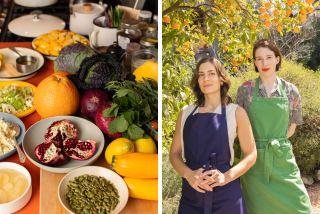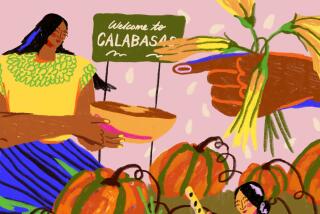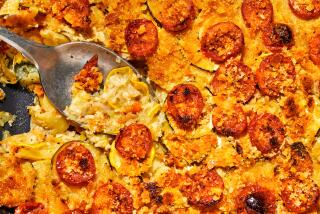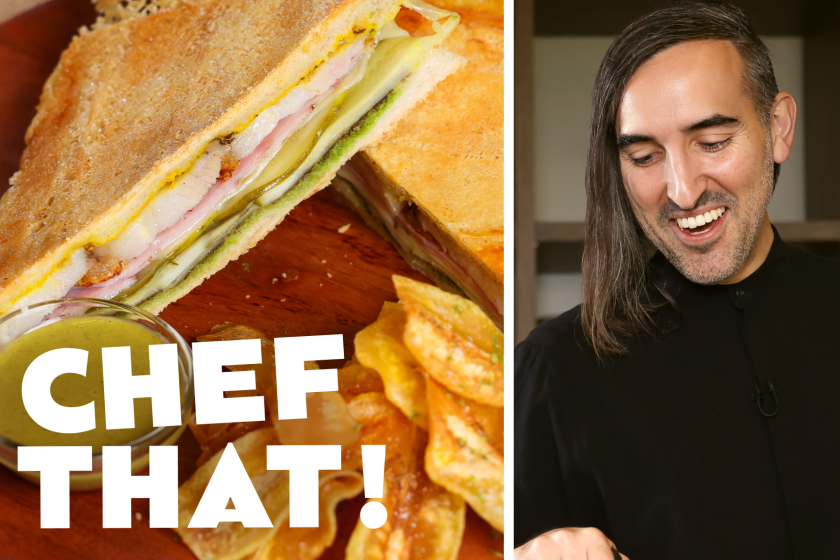This winter squash by chef Gary Menes is so good it could outshine the Thanksgiving turkey

A Thanksgiving squash dish made by chef Gary Menes of Le Comptoir restaurant.
Winter squash usually gets short shrift at the holiday table, relegated to pumpkin pie or maybe a side dish for those who can’t abide sweet potatoes. In the hands of Le Comptoir chef Gary Menes, though, this oft-overlooked vegetable can become the star of the show — even replacing the turkey.
Menes, whose tiny Koreatown restaurant features mainly vegetables he grows himself at a garden in Long Beach, has been dubbed the “vegetable whisperer.” Restaurant critic Jonathan Gold ranked Le Comptoir No. 35 of his top 101 restaurants in Southern California. Of course, it takes a lot more than murmuring sweet nothings to make a squash dish that’s worthy of being a Thanksgiving centerpiece.
RECIPE: Chef Gary Menes’ winter squash
Menes first roasts the squash until it’s almost tender, then sautés it while basting with butter. He serves it with roasted onions, chewy wheat berries, a crunchy, tart relish and meaty, long-cooked onion jus. It’s labor-intensive, to be sure, but the work can easily be spread across several days — and simply sautéed and assembled right before serving.
The dish has changed very little since Menes first served it almost 10 years ago when he was cooking at Palate Food + Wine in Glendale.
“Barbara Spencer [of Windrose Farm] had blue Hubbards available, and I remember thinking what a shame it would be to cook them and puree them for a soup,” Menes says. At the same time, he’d been thinking of a way to get more vegetables on the meat-heavy menu.
Menes remembered a photo he’d seen of French chef Alain Ducasse sautéing wedges of Musquèe de Provence pumpkin in butter and herbs in a black steel pan. “It was so sexy in its simplicity and its beauty.” From that image, the dish was born. But it did need some filling out.
“Because the squash, although it does have some texture and thickness to it, doesn’t quite have the texture of meat, you need a little bit of a pop in there,” Menes says. “I thought of wheat berries, because no matter how long you cook them, they still have a bit of a chew.
“Then you get some of the sweet-sour crunchy from the relish too. And then with the slow-cooked onion jus, you’d get that kind of meaty sauce that you’re craving. Honestly, it hasn’t changed much since I first served it,” he says.
Well, with one exception — since a cook can’t count on a constant supply of blue Hubbards (even when he grows them himself), Menes has sampled widely from the winter squash palate.
“I’ve used everything from candy roasters to red and blue Hubbards,” he says. “I’ve used kuri squash. I’ve used acorn squash. I’ve used three different butternut squashes. I’ve used kabochas, the blue one as well as the green and orange too. And probably my favorite of them all because it’s so dramatic is the Musquèe de Provence.”
As you might expect, he has firm opinions about the different squashes. Menes says kabocha is drier and tastes more like Japanese sweet potato than other squashes, which tend to be nuttier. Butternut squash has a lot of moisture and is very sweet. “At times we shave it really thin and serve it raw along with the dish to give a sense of crunch.”
THANKSGIVING GUIDE: Get ready for Turkey Day with recipes, entertaining tips and more
Kuri squash has an almost ideal water content and the smell is like summer melons. Blue Hubbard smells like summer melon too; it has a distinct savoriness. Musquèe de Provence, which is also called fairytale, is not sugar-sweet at all but is more savory. It is juicy and caramelizes beautifully.
Whichever squash you use, be sure to taste it and adjust the seasoning accordingly. Really sweet varieties such as butternut might take a little more vinegar in the jus to balance the flavors. The variability is part of the beauty of the dish.
“Each squash has its own set of characteristics and loveliness,” Menes says. “That’s just the quality of it, and that’s the beauty of it and you just enjoy it for what it is.”
::
Gary Menes’ tips for best results with that squash recipe
Though Gary Menes’ squash recipe might seem daunting, none of the individual steps is difficult. But the chef does have some tips to make the dish shine:
Menes cooks the squash with the skin on (“on the bone,” he says) because that helps hold the tender flesh together.
Don’t roast the squash as long as you normally would. Because it will be sauteed, it’s best to leave it a little firm to help keep it in one piece and to prevent overcooking.
Saute the squash over medium-low heat so it caramelizes slowly without scorching.
If the herbs in the saute pan start to brown, remove them and replace them with fresh.
Keep spooning the butter mixture over the squash while it’s sauteeing. “Not only is it transformative of the flavor, the squash caramelizes a lot more than if you just leave it setting in the pan.”
Menes prefers Plugra or another European-style cultured butter for its complexity of flavor.
Cook the orange juice for the relish at a slow simmer to keep the flavor fresh and to avoid scorching.
Add the pumpkin seeds and the raw onion to the relish at the very end to keep their pop of texture and flavor.
ALSO:
Don’t panic! Carving a turkey doesn’t have to be scary. Here’s how to do it
Jonathan Gold shares his secrets to the perfect Thanksgiving stuffing
Why you should get up before the sun on Thanksgiving to bake a great pumpkin pie
Admit it, you love canned cranberries. But this homemade version just might win you over
More to Read
Eat your way across L.A.
Get our weekly Tasting Notes newsletter for reviews, news and more.
You may occasionally receive promotional content from the Los Angeles Times.











